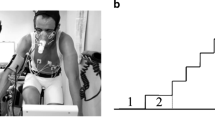Summary
The method described by Wasserman for anaerobic threshold (AT) determination, based on the recording of ventilatory parameters, was supported by the simultaneous appearance of hyperlactacidemia and hyperventilation during a standardized incremental work test. Our study aimed at testing the AT in another profile of exercise, viz., during exercises at constant workloads.
A homogenous population of 66 healthy subjects performed on a treadmill a total of 100 exercises of 20 min duration at constant workloads (43, 48, 52, 57, 63, and 71% \(\dot V\)O2max). The \(\dot V\)O2, \(\dot V\), and venous plasma lactic acid (LA) were determined every minute.
LA showed an initial transient increase at 43% \(\dot V\)O2 max and a steady-state elevated level above 48% \(\dot V\)O2 max. In contrast, the hyperventilation threshold (HVT) was only observed above 57% \(\dot V\)O2 max, simultaneously with a delayed steady-state \(\dot V\)O2 and with a sustained increase of lactate until the end of exercise.
The meaning of the simultaneity of these three events must still be studied. However, the dissociation between both early and steady-state lactate thresholds and HVT is not in keeping with the concept of AT. In these conditions, there is no evidence that HVT necessarily represents an AT, viz., a critical intensity of exercise inducing an insufficient oxygen delivery to the muscles. This conclusion does not imply that the measurement of HVT should be rejected as an empirical test of physical fitness.
Similar content being viewed by others
References
Asmussen E, Nielsen M (1946) Studies on the regulation of respiration in heavy work. Acta Physiol Scand 12: 171–188
Bang O (1936) The lactate content of the blood during and after muscular exercise in man. Scand Arch Physiol 74: [Suppl] 49–82
Dempsey JA, Gledhill N, Reddan WG, Forster HV, Hanson PG, Claremont AD (1977) Pulmonary adaptation to exercise: effects of exercise type and duration, chronic hypoxia, and physical training. Ann NY Acad Sci 301: 243–261
Fletcher WM, Hopkins FG (1907) Lactic acid in amphibian muscle. J Physiol 35: 247–309
Gimenez M, Hennequin R, Horsky P, Colas Th, Saunier C (1974) Evolution de la lactacidémie, de l'équilibre acido-basique électrolytique au cours d'un exercise musculaire rectangulaire de 20 minutes chez l'homme à différentes charges et à la “puissance maximale supportée”. Bull Physio-Pathol Resp 10: 463–479
Graham T, Sjogaard G, Lollgen H, Saltin B (1978) NAD in muscle of man at rest and during exercise. Pflügers Arch 376: 35–39
Hermansen L, Stensvold I (1972) Production and removal of lactate during exercise in man. Acta Physiol Scand 86: 191–201
Jones NL (1980) Hydrogen ion balance during exercise. Clin Sci 59: 85–91
Lundholm L, Mohme-Lundholm E, Vamos N (1963) Lactic acid assay with L (+) lactic dehydrogenase from rabbit muscle. Acta Physiol Scand 58: 243–249
Lundin G, Strom G (1947) The concentration of blood lactic acid in man during muscular work in relation to the partial pressure of oxygen of the inspired air. Acta Physiol Scand 13: 253–266
Margaria R, Edwards HT, Dill DE (1933) The possible mechanisms of contracting and paying the oxygen debt and the role of lactic acid in muscular contraction. Am J Physiol 106: 689–715
Margaria R, Meschia G, Marro F (1954) Determination of O2 consumption with Pauling oxygen meter. J Appl Physiol 6: 776–780
Owles WH (1930) Alterations in the lactic acid content of the blood as a result of light exercise and associated changes in the CO2 combining power of the blood and in the alveolar CO2 pressure. J Physiol 69: 214–237
Pendergast D, Cerretelli P, Rennie DW (1979) Aerobic and glycolytic metabolism in arm exercise. J Appl Physiol 47: 754–760
Pirnay F, Petit JM, Bottin R, Deroanne R, Juchmes J, Belge O (1966) Comparaison de deux méthodes de mesure de la consommation maximum d'oxygène. Int Z Angew Physiol 23: 203–211
Snedecor GW (1966) Statistical methods 5th edition. Iowa State University Press, Ames
Wasserman K, Whipp BJ, Koyal SN, Beaver WL (1973) Anaerobic threshold and respiratory gas exchange during exercise. J Appl Physiol 35: 236–243
Wasserman K, Whipp BJ (1975) Exercise physiology in health and disease. Am Rev Resp Dis 112: 219–249
Wasserman K (1978) Breathing during exercise. New EngL J Med 298: 780–785
Whipp BJ, Wasserman K (1972) Oxygen uptake kinetics for various intensities of constant load work. J Appl Physiol 33: 351–356
Author information
Authors and Affiliations
Rights and permissions
About this article
Cite this article
Scheen, A., Juchmes, J. & Cession-Fossion, A. Critical analysis of the “anaerobic threshold” during exercise at constant workloads. Europ. J. Appl. Physiol. 46, 367–377 (1981). https://doi.org/10.1007/BF00422124
Accepted:
Issue Date:
DOI: https://doi.org/10.1007/BF00422124




